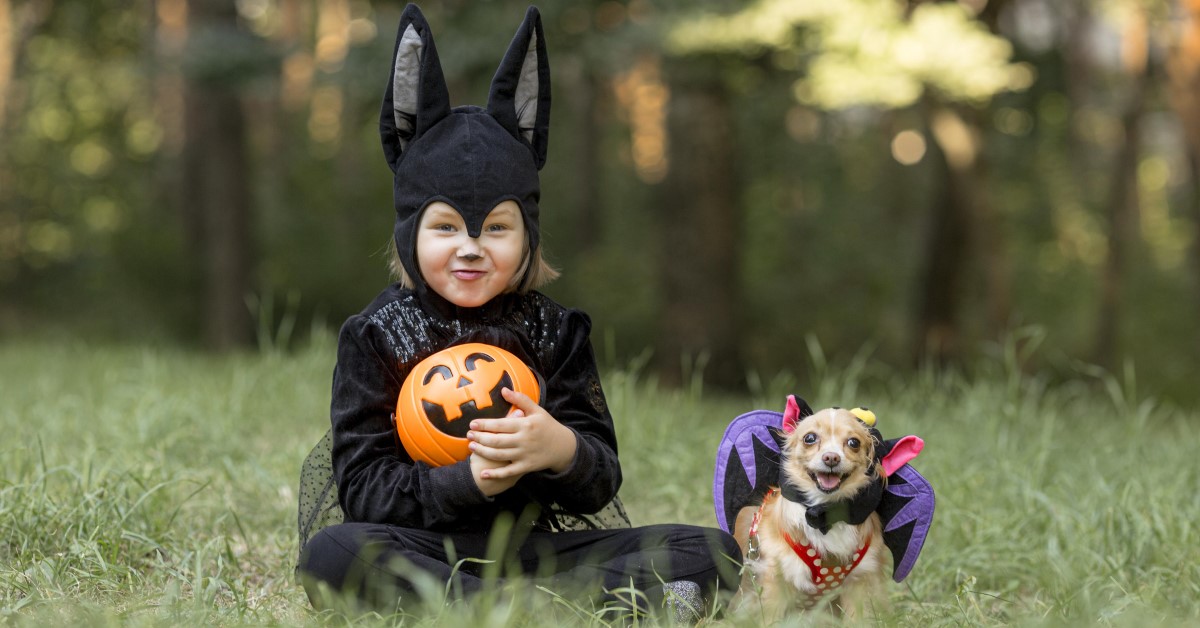Trick or Treat! A Happier Halloween for Your Pet
Halloween doesn't have to be all trick and no treat for your beloved pet.

People love Halloween for all kinds of reasons, from entertaining chills to raucous fun with friends and family members. But what about the non-human members of your family? Dogs and cats don't necessarily experience Halloween the way you do, while some of the seasonal fun you enjoy could prove downright harmful to your furry friend. Let's look at some strategies for ensuring that your pet enjoys (or at least endures) Halloween as safely and happily as possible.
Halloween Treats You Shouldn't Feed Your Pet
Halloween and treats naturally go together, from the candy your kids collect to the refreshments you lay out for your grownup party guests. However, many of the Halloween goodies you enjoy without incident can do serious harm to your pet. Examples include:
- Chocolate - Chocolate contains both caffeine, a potent nervous system stimulant, and substances called methylxanthines that can cause vomiting, seizures, or even death.
- Alcohol - It should go without saying you don't want to feed your pet this toxic central nervous system depressant.
- Citrus fruits, seeds, and peels - Citrus products can irritate your pet's digestive system.
- Macadamia nuts - These tasty treats can send your dog's metabolism into overdrive, producing tremors, weakness, and other upsetting symptoms.
- Nuts in general - The fatty oils in many popular nuts can trigger pancreatitis, vomiting, and diarrhea in pets.
- Grapes and raisins - These fruits contain tartaric acid, which might make your pet's kidneys fail.
- Xylitol - This non-sugar sweetener may be good for your waistline, but it's potentially deadly to dogs and cats.
Keep these human foods out of paw's reach during your Halloween holiday. (Be sure to pick up any such treats that accidentally fall on the floor!) You can always feed your pet its regular favorite treats as part of the festivities.
Halloween Parties and Pets
The aforementioned treats don't represent the only potential trouble your pet might encounter at a Halloween party. These affairs can get quite noisy and chaotic. Spooky sounds, ominous lighting, and scary costumes that hide familiar faces can ratchet up your dog or cat's anxiety. Create a "hiding place" your pet can go to when the party gets to be a bit much. A separate, enclosed room with all the essentials (including comforts such as favorite toys and blankets) will offer a soothing escape.
Speaking of escape, bear in mind that an anxious or overexcited pet may dash through an open door and into the night, potentially getting lost in the process. You can prepare for this possibility by having your vet inject a tiny microchip under your pet's skin. This chip emits an RF signal containing ID information, allowing rescuers to trace it back to you. You can also consider a digital pet ID tag for your dog or cat, which can actually return them home faster than a microchip
Keep your pet's safety in mind as you decorate your home for Halloween. Exposed electrical wires, open flames such as candles, and any items that might poke or choke your pet have no place at a pet-friendly Halloween party. Clear away any scissors, sharp objects, or costume pieces as soon as you've finished your preparations.
Costume or No Costume?
Yes, the image of a Dachshund dressed as a hot dog or a cat costumed as a ferocious lion can be an adorable sight. But before you cram your four-legged family member into a Halloween costume, ask yourself whether your pet usually enjoys feeling confined by clothing. Many pets hate wearing clothes, even when extreme weather makes it a must. If you know your pet will hate the experience, switch from a full-body costume to a minimal alternative or just skip the costume altogether.
If your pet will tolerate a costume, make sure to select a safe costume. Avoid any costume that restricts your pet's breathing, hearing, or vision.
Taking Your Pet Trick-or-Treating
Whether you put your pet in a costume or not, you may still want to take it trick-or-treating with the family. However, this strategy could create problems if you don't think it through, just as you'd want to take certain precautions to protect trick-or-treating children.
The first question worth asking is: How well socialized is your pet? Some pets feel totally comfortable around adults, kids, and other pets while also knowing how to walk on a leash and obey commands such as "Sit" and Down." Reward your pet with treats when it responds correctly. But if you have any concerns about how your pet will behave in its encounters with others, just leave it at home.
The second question is: How can you keep your pet safe while trick-or-treating? A dark night in a neighborhood where cars roam can lead to a tragic accident unless you've fitted your pet with high-visibility gear such as a reflective vest. Watch your pet carefully to make certain it doesn't accept candy that might have toxic effects.
How Your Vet Can Help
You might be surprised at how much your trusted veterinarian can help you provide a better Halloween experience for your dog or cat. For instance, anxious animals likely to be unnerved by the goings-on might benefit from natural or pharmaceutical calming agents. Your vet can also recommend specific pet-friendly treats, socialization advice, and additional tips to help safeguard your pet. Make that appointment today so you can rest assured that you've done all your can to give your pet a happy Halloween!
Ready to start saving money on pet wellness care?
Then take a look at Mint Wellness, the pet wellness plan that provides fast reimbursement on routine pet care. Save on vaccinations, wellness exams, preventatives, dental, and more!
Learn More


